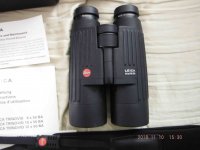Under what circumstances would a 10x50 be dimmer than a 8x32?
Background: I had the chance to buy a Leica Trinovid 10x50 BA. Optics clean, no fungus or hazing. Cosmetically excellent. I adjusted the diopter and looked. Sharp in-focus image, CA mild but visible. Then I used my Swarovski EL 8x32 SV to compare.
The EL was definitely brighter and colours looked more saturated. The comparison was in bright sunlight on a building rooftop. About 20m away was a children's playground with colourful structures, and a spotted dove was perched about 30m away.
The Leica's image was larger but obviously dimmer, and the colours appeared faded. I did not buy it.
In bright sunlight my pupils should contract to about 2mm, and both binoculars should produce equally bright images. This was not the case. It was not close. I wore both units and swapped between them several times to confirm it.
What could be the reason for the Leica being dimmer? Lower transmission? But even if the Leica transmitted only 80% and the EL transmitted 100% (impossible) the Leica would still be ahead because of its larger aperture, am I correct?
Actual transmission data I found for a 8x32 Trinovid BN was about 77%, 8x32 EL SV about 91%. The BA could be a little less than the BN, but total light gathering for the 10x50 BA should still beat the 8x32 EL SV. Data source (pages 26 and 33):
Or... was there something wrong with the Leica? Or does it simply have a more yellow tint, thus making it appear less bright? Unfortunately I forgot to note the serial number of the unit, I understand Leica made some mid-stream coatings upgrades for its binoculars.
Basically, I would like to know whether I should skip binoculars of the Leica's vintage (1995-2000) and look for something newer (2010 onwards), or find a better sample.
Intended usage: observing raptors in flight (10-20%) and astronomy (80-90%).
I live in a large, light-polluted city, with many green spaces and wetlands within easy cycling distance. I already have 8x32 (and also 8x42) so 10x50 or 12x50 could be useful.
My spotting scope starts at 19x with my eyepieces. From 8x binoculars the logical jump is to 12x (or 10x if 12x cannot be held stable). Because I have to carry everything in a backpack and cycle to my observing sites, I would set 56mm as maximum size (around 1.2kg).
If anyone has any suggestions or comments, please feel free to chime in. This is not a Leica-bashing thread, if the consensus is the unit I saw was a lemon, I'll audition other units. I was all set to buy the Leica until I took out my EL and saw the difference.
Background: I had the chance to buy a Leica Trinovid 10x50 BA. Optics clean, no fungus or hazing. Cosmetically excellent. I adjusted the diopter and looked. Sharp in-focus image, CA mild but visible. Then I used my Swarovski EL 8x32 SV to compare.
The EL was definitely brighter and colours looked more saturated. The comparison was in bright sunlight on a building rooftop. About 20m away was a children's playground with colourful structures, and a spotted dove was perched about 30m away.
The Leica's image was larger but obviously dimmer, and the colours appeared faded. I did not buy it.
In bright sunlight my pupils should contract to about 2mm, and both binoculars should produce equally bright images. This was not the case. It was not close. I wore both units and swapped between them several times to confirm it.
What could be the reason for the Leica being dimmer? Lower transmission? But even if the Leica transmitted only 80% and the EL transmitted 100% (impossible) the Leica would still be ahead because of its larger aperture, am I correct?
Actual transmission data I found for a 8x32 Trinovid BN was about 77%, 8x32 EL SV about 91%. The BA could be a little less than the BN, but total light gathering for the 10x50 BA should still beat the 8x32 EL SV. Data source (pages 26 and 33):
Or... was there something wrong with the Leica? Or does it simply have a more yellow tint, thus making it appear less bright? Unfortunately I forgot to note the serial number of the unit, I understand Leica made some mid-stream coatings upgrades for its binoculars.
Basically, I would like to know whether I should skip binoculars of the Leica's vintage (1995-2000) and look for something newer (2010 onwards), or find a better sample.
Intended usage: observing raptors in flight (10-20%) and astronomy (80-90%).
I live in a large, light-polluted city, with many green spaces and wetlands within easy cycling distance. I already have 8x32 (and also 8x42) so 10x50 or 12x50 could be useful.
My spotting scope starts at 19x with my eyepieces. From 8x binoculars the logical jump is to 12x (or 10x if 12x cannot be held stable). Because I have to carry everything in a backpack and cycle to my observing sites, I would set 56mm as maximum size (around 1.2kg).
If anyone has any suggestions or comments, please feel free to chime in. This is not a Leica-bashing thread, if the consensus is the unit I saw was a lemon, I'll audition other units. I was all set to buy the Leica until I took out my EL and saw the difference.









